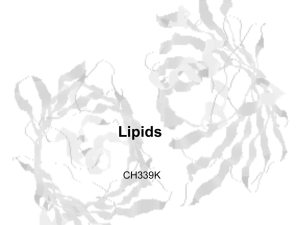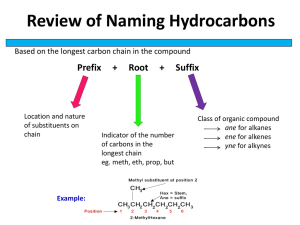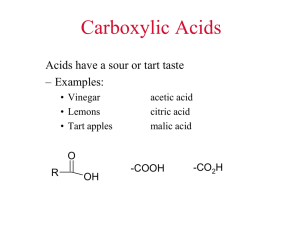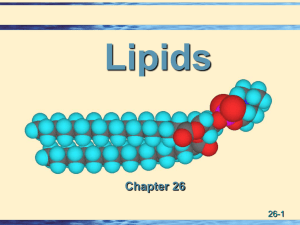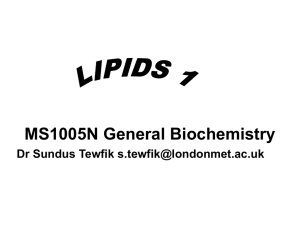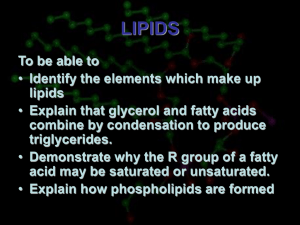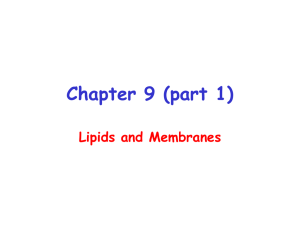3. lipids - Biochemistry Notes
advertisement
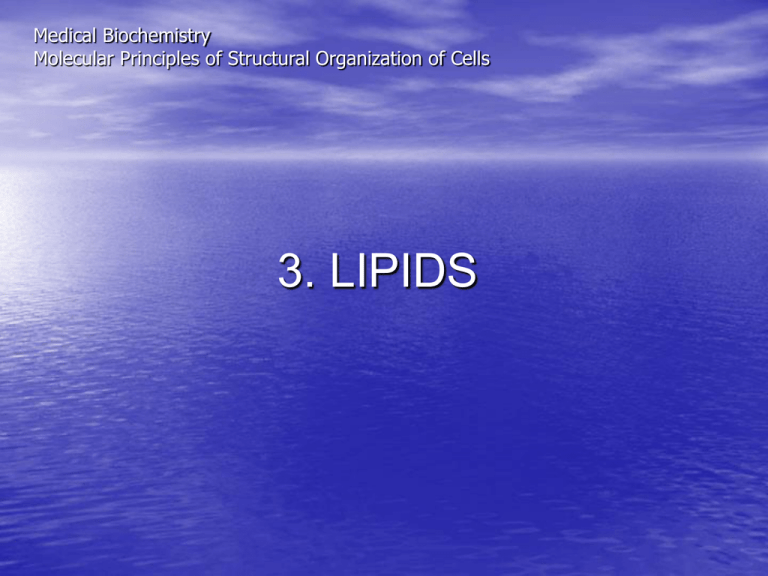
Medical Biochemistry Molecular Principles of Structural Organization of Cells 3. LIPIDS LIPIDS • Organic compounds of biological nature • Due to the predominence of hydrocarbon chains in their structure (-CH2CH2-CH2-), they have a hydrophobic nature which explains why – they are insoluble or poorly soluble in water and – soluble in nonpolar solvents (chloroform, ether, benzene). Classification: • depending on their physico-chemical properties (polarity): – neutral, nonpolar (with no charge) – polar (charged) • depending on physiological importance: – reserve – stored, used to supply energetic needs (acylglycerides) – structural – used to buildup the biological membranes, protective layers in plants, insects, skin of vertebrates; Location: lipids represent 10-20% of the body mass (10-12 Kg) of which – 98% is the reserve in the fat tissue, – structural lipids (2-3 Kg) exist in membranes (40% of the dry weight); the richest tissue in lipids is the nervous tissue (20-25%) COMPONENTS OF LIPIDS 1. FATTY ACIDS (FA) FA are derivatives of aliphatic hydrocarbons that contain – COOH H H H H H H H H H l l l l l l l l l l l l l l l l H H H H H H H H l l l l l l l l l l l l l l l l l l H - C – C – C – C – C – C – C – C – C – C – C – C – C – C – C – C – C – COOH H H H H H H H H H H H H H H H H H CH3-CH2-CH2-CH2-CH2-CH2-CH2-CH2-CH2-CH2-CH2-CH2-CH2-CH2-CH2-CH2-CH2- COOH hydrocarbon chain carboxyl (nonpolar “tail”) (polar”head”) stearic acid Physical properties: • FA have an amphipatic nature (polar and nonpolar) and in biphasic systems they orient with the polar end associated with water and the nonpolar end associated with the hydrophobic phase (detergent–like) • The melting point is related to – chain length: the longer the chain - the higher the melting point, – number of double bonds: the greater the number of doublebonds – the lower the melting point Classified in: - Saturated - Unsaturated Saturated FA = zig-zag hydrocarbon chains with even number of C (12-18); H2 C H3C H2 C C H2 H2 C C H2 H2 C C H2 H2 C C H2 H2 C C H2 H2 C C H2 COOH C H2 palmitic 16 hexadecanoic CH3-(CH2)14-COOH stearic 18 octadecanoic CH3-(CH2)16-COOH lignoceric 24 tetracosanoic CH3-(CH2)22-COOH -hydroxylignoceric CH3-(CH2)21-CH(OH)-COOH cerebronic 24 Chains with odd number of C exist occasionally, in small amounts in animal tissues. Unsaturated FA (monoenic, dienic, trienic, tetraenic,…polyenic); palmitoleic acid 16:1 Δ9 CH3-(CH2)5-CH=CH-(CH2)7-COOH oleic acid 18:1 Δ9 CH3-(CH2)7-CH=CH-(CH2)7-COOH linoleic acid (LA) 18:2 Δ9,12 α-linolenic acid (ALA) 18:3 Δ9,12,15 arachidonic acid (AA) 20:4 Δ5,8,11,14 CH3-(CH2)4-CH=CH-CH2-CH=CH-(CH2)7-COOH CH3-CH2-CH=CH-CH2-CH=CH-CH2-CH=CH-(CH2)7-COOH CH3-(CH2)4-CH=CH-CH2-CH=CH-CH2-CH=CH-CH2-CH=CH-(CH2)3COOH Short-chain polyunsaturated fatty acids (SC-PUFA) LA and ALA can not be synthesized by humans as they lack the enzymes required for their production. – – – – – They form the starting point for the production of long-chain FA (LC-PUFA) Gamma-linolenic acid = GLA (18:3) Dihomo-gamma linolenic acid = DGLA (20:3) Arachidonic acid = AA (20:4) Eicosapentaenoic = EPA (20:5) Docosahexaenoic = DHA (22:6) – FA nomenclature: • Δ system: palmitoleic acid: 16:1: Δ9 • systematic name: – palmitoleic acid = cis-Δ9-hexadecenoic acid – oleic acid = cis-Δ9-octadecenoic acid – linoleic acid = cis-Δ9 Δ 12-octadecadienoic acid – linolenic acid = cis-Δ9 Δ 12 Δ 15 -octadecatrienoic acid – arachidonic acid = cis-Δ5 Δ8 Δ 11 Δ 14-eicosatetraenoic – FA are classified in 4 families depending on the number of C from the terminal CH3 up to the first double bond : • ω-3 linolenic acid (ALA) CH3- CH2 -CH=CH-R eicosapentaenoic (EPA) docosahexaenoic (DHA) • ω-6 linoleic acid (LA) CH3-(CH2)4-CH=CH-R gamma-linolenic acid (GLA) dihomo-gamma linolenic acid (DGLA) arachidonic acid (AA) • ω-7 palmitoleic acid CH3-(CH2)5-CH=CH-R • ω-9 oleic acid CH3-(CH2)7-CH=CH-R FA with a double bond beyond C9 are not synthesized in the human body, are “essential FA” or “vitamins F”: linoleic, linolenic, arachidonic acids ω-9 are not essential in humans, because humans generally possess all the enzymes required for their synthesis PROSTAGLANDINS (PG) • Hormone-like compounds: – synthesized at need, in small amounts, starting from arachidonic acid, – with short life, – exert a local action at the site of formation • Location: – first isolated from prostate; – they can occur in all cells and organs except erythrocytes • Structure: derived from C20-polyene FA, containing a cyclopentane ring; – depending on the type and number of oxygen substituents and location of double bonds in the cyclopentane ring they have several types: A, B, C, D, E, F, G, H; – depending on the number of double bonds in the side chains, they are: PGE1, PGE2, PGE3 or PGF1, PGF2, etc • Prostaglandins action • In the endocrine glands : – adrenal glands – stimulate the formation of steroid hormones and secretion of catecholamines – thyroid gland – synthesis of iodothyronines – pancreas – the release of insulin • Control of smooth muscles of bronchi, intestine, uterus (cGMP, Ca2+) – Bronchi muscles contracted by PGD2, PGG2, PGH2 and relaxed by PGE – Blood vessels muscles are contracted by PGF2 and relaxed by PGE2 (influence the blood pressure) – PGE2 increases the volume of urinary discharge and Na+ concentration in urine – PGF2 stimulates the contraction of uterus and fallopian tubes, increases the involution of corpus luteum, facilitating the birth – PG intensify the intestinal motility • The gastric juice secretion is inhibited by PGE and stimulated by PGF2 The disturbance of production may determine inflammation, thrombosis, gastric ulcer or may prevent the ulcer of intestinal or gastric mucosae. PGF2 (dinoprost) is used in obstetric practice for pregnancy termination PGE2 (dinoprostone) is used to stop the bronchi spasm, treat hypertension or peptic ulcer THROMBOXANES (TX) • Structure: – analogs of prostanoic acid with a six-membered ring containing oxygen, – the different capital letters designate the combinations of the ring substituents, – the number shows the number of unsaturated bonds • Functions: – TXA2 is produced by platelets causing contraction of the arteries and triggering the platelet aggregation, an opposite action to PGI2 (prostacyclin) produced by the endothelial cells of the vascular system (balanced working) HYDROPEROXYEICOSATETRAENOIC ACIDS (HPETEs) • Hydroxy-FA derivatives of arachidonic acid, with no ring structure • Function – they can be converted in active compounds such as leukotrienes. LEUKOTRIENES (LT) • Formed from HPETEs by lipooxygenase, • Structure: – have 3 conjugated double bonds (those formed from arachidonic acid have 4), – an additional letter shows the modification to the carbon chain (LTA4, LTB4), • Functions: involved in chemotaxis, inflammation, allergic reactions – LTD4 = the slow-reacting substance of anaphylaxis (SRS-A) which causes the contraction of smooth muscle of bronchi, blood vessels, coronary arteries – LTB4 attracts the neutrophils and eosinophils at the site of inflammation 2. ALCOHOLS • Aliphatic alcohols without nitrogen – Glycerol CH2 - OH l CH - OH l – Higher aliphatic alcohols: stearylic alcohol CH2 - OH CH3-(CH2)16-CH2- OH – – – – Ethanolamine = colamine Choline Serine Sphingosine CH - (CH ) - CH = CH - CH - OH 3 2 12 HO- CH2-CH2-NH2 HO- CH2-CH2-N+(CH3)3 HO- CH2-CH(COOH)-NH2 Dihydrosphingosine CH - (CH ) -CH -CH - CH - OH 3 2 12 2 2 • Aliphatic alcohols with nitrogen (aminoalcohols) CH - NH2 CH - NH2 CH 2 - OH CH 2 - OH • Cyclic alcohols: – Inositol H OH – OH OH H OH H H OH H H OH Sterols • Steroids = compounds containing a hydrocarbon skeletal framework as that of gonane (sterane); those which contain a hydroxyl group and can form esters are named sterols • Origin: – animal – zoosterols; e.g. cholesterol – plant – fitosterols; e.g. β-sitosterol 12 11 CHOLESTEROL 1 10 2 A 13 14 B 16 D C 9 17 15 8 7 3 5 4 6 HO • Exists in mammalian tissues free or esterified. • Location: – – – – nervous tissue (only free), adrenal glands (>80% esterified), liver, serum (70-80% esterified) • Structural lipid – part of cell membrane (more than the membranes of mitochondria, microsomes, nuclei), influencing the membrane fluidity • Cholesterol functions: OH – In the liver: COOH • oxidation of the side chain results in bile acids • • • • (cholic and deoxycholic acids = primary bile acids); they are conjugated with glycine or taurine forming glycocholic acid or taurocholic acid eliminated in the bile as bile salts (sodium or potassium glycocholate or taurocholate). chenodeoxycholic and lithocholic are secondary bile acids formed in the intestine (bacterial enzymes) The bile salts are amphypatic molecules with surface-active properties, favoring the emulsification of lipids in the intestine; they assist the absorption of fat-soluble vitamins. The low solubility may favor the formation of gall stones. – Synthesis of steroid hormones in • adrenal glands (glucocorticoid, mineralcorticoid) • testis (testosterone), • ovary (estradiol, progesterone), • placenta (progesterone). – Steroid vitamins (vitamins D) HO OH Cholic acid OH COOH HO Deoxycholic acid COOH HO Chenodeoxycholic acid COOH Lithocholic acid OH OH OH COOH HO OH CO-NH-CH 2-CH 2-SO 3-Na + CO-NH-CH 2-CH 2-SO 3H HO OH HO taurocholic acid cholic acid OH sodium taurocholate OH OH CO-NH-CH 2-COOH HO OH CO-NH-CH 2-COO -Na+ HO OH glycocholic acid sodium glycocholate BILE ACID CONJUGATED BILE ACID BILE SALTS CLASSIFICATION OF LIPIDS I.HOMOLIPIDS (SIMPLE LIPIDS) - esters composed of lipid monomers - fatty acids + alcohols - ester bonds 1. GLYCERIDES or ACYLGLYCERIDES (esters of fatty acids with tribasic alcohol: glycerol) 2. STERIDS (esters of fatty acids with sterols) 3. WAXES (esters of fatty acids with higher monobasic alcohols) LIPIDS with N II.HETEROLIPIDS (COMPLEX LIPIDS) - ester or amide bonds 1. GLYCEROPHOSPHOLIPIDS (PHOSPHOLIPIDS) - all contain P - alcohol: glycerol - ester bonds without N with P 2. SPHINGOLIPIDS - all contain N - alcohol: sphingosine - amide bonds without P LECYTINES CEPHALINES SERINCEPHALINES PLASMALOGENS PHOSPHATIDIC ACIDS PHOSPHATIDYL-INOSITOL CARDIOLIPINS SPHINGOMYELINS CERAMIDES CEREBROSIDES SULPHOLIPIDS GANGLIOSIDES I. SIMPLE LIPIDS 1. ACYLGLYCERIDES • Esters of glycerol with fatty acids • Neutral lipids • Classified in mono-, di-, tri-glycerides containing 1, 2, 3 acyl (R-CO-): – simple acylglycerides: residues of the same FA (R1=R2=R3) – complex acylglycerides: residues from different FA CH2 – OH l CH – OH l CH2 – OH glycerol HO-CO-R1 + HO-CO-R2 HO-CO-R3 fatty acids -3H2O CH2 – O – CO - R1 l CH – O – CO - R2 l CH2 - O – CO - R3 triglyceride (TG) • Natural neutral lipids are almost exclusively triglycerides (TG); mono- and di-acylglycerides are formed in the intestine during the digestion and absorption. CH 2 - O - CO - R1 CH 2 - O - CO - R1 CH 2 - O - CO - R1 CH - OH CH - O - CO - R2 CH - O - CO - R2 CH 2 - OH CH 2 - OH CH 2 - O - CO - R3 monoacylglyceride diacylglyceride triacylglycerides • Natural fats are mixtures of simple and complex TG, with the • prevalence of unsaturated TG. In the human body they contain: – – – – – oleic acid palmitic acid linoleic acid palmitoleic acid stearic acid 45%, 25%, 8%, 7%, 6% • Physico-chemical properties: – The melting point increases with proportion of saturated fatty acids – Less dense than water – Soluble in nonpolar solvents; only mono and diglycerides are water soluble (contain free -OH) forming micelles in water; TG do not. – Basic hydrolysis (saponification) → glycerol + free fatty acids salts CH2 - O - CO - R1 CH - O - CO - R2 CH2 - OH + 3KOH CH2 - O - CO - R3 CH - OH R1-COOK + R2-COOK R3-COOK CH2 - OH – In the organism, the hydrolysis is catalyzed by lipase CH 2 - O - CO - R1 CH - O - CO - R2 CH 2 - O - CO - R3 CH 2 - OH + 3 H2O CH - OH CH 2 - OH R1-COOH + R2-COOH R3-COOH I. SIMPLE LIPIDS 2. STERIDS R-OC-O • • • • Esters of cholesterol with fatty acid Exist in products of animal origin (butter, egg yolk) In the human tissue cholesterides = 75% of total cholesterol In the blood enter in the structure of lipoproteins I. SIMPLE LIPIDS 3. WAXES • Mixtures of ethers and esters of higher monobasic alcohols and higher fatty acids, usually – cetylic alcohol – stearylic alcohol CH3-(CH2)14-CH2-OH CH3-(CH2)18-CH2-OH CH3 -(CH2)14-COOH + CH3-(CH2)14-CH2-OH CH3-(CH2)14-CO-O-CH2 -(CH2)14-CH3 - H2O palmitic acid • cetylic alcohol cetylic palmitate They are products of the animal or plant epidermis, serve as protective film against water loss or wetting (high hydrophobic): e.g. leaves and fruits, skin and hair, feathers, skeleton of insects, honey wax. Energy reserve material (marine animals) II. COMPLEX LIPIDS (HETEROLIPIDS) 1. PHOSPHOLIPIDS • Complex lipids representative of phosphate-substituted • • • • esters of diverse organic alcohols. Are polar lipids Predominantly contained in the membranes, structural components of organs, mainly in brain and nerves Take part in metabolic processes: involved in intestinal fat resorption, fatty acid transport and oxidation, fatty infiltration of the liver, blood coagulation, prostaglandin synthesis Classified in: – phosphoacylglycerides – sphingolipids II. COMPLEX LIPIDS (HETEROLIPIDS) 1. PHOSPHOLIPIDS (PHOSPHOACYLGLYCERIDES) CH 2 - O - CO - R1 nonpolar, hydrophobic CH - O - CO - R2 CH 2 - O - P - X amphipatic structure polar, hydrophylic OH O • Structure: • The alcohol = glycerol – the –OH in C1 is esterified with a saturated FA nonpolar – the –OH in C2 is esterified with an unsaturated FA (trans) hydrophobic – the –OH in C3 forms an phosphoester bond with a H3PO4 polar – X is an alcohol residue hydrophylic = amphipatic character which makes them easily soluble in nonpolar solvents and in water forming micelles (the hydrophobic radicals oriented to the inner hydrophobic zone; the hydrophylic groups are located on the outer surface toward the aqueous phase) They bear both negatively and positively charged groups = amphoteric character 1. PHOSPHOLIPIDS (PHOSPHOACYLGLYCERIDES) 1.1. With N 1.1.1. Lecithins (phosphatidylcholines) – Structure: FA = oleic, palmitic, stearic acids, (in brain poliunsaturated, > 20 C) X = choline HO-CH2-CH2-N+(CH3)3 the –OH is ionized and associated with K+, Na+, Ca2+ – Location: membranes (50% of lipids in membrane) 1.1.2. Cephalins (phosphatidyletanolamines) – Structure: FA = oleic, stearic X = ethanolamine=cholamine HO-CH2-CH2-NH2 – Location: intracellular membranes of animal cells (20%) in all tissues, blood lipoproteins; in plants, microorganisms 1.1.3. Serincephalins (phosphatidylserines) – Structure: X = serine – Location: most animal tissue (brain) 1.1.4. Plasmalogens – Structure: the –OH in C1 forms an ether bond with an acetal X = colamine – Location: all tissues, mainly in brain and spinal cord (50-90%) HO-CH2-CH-NH2 │ COOH HO-CH=CH-CH2-R1 HO-CH2-CH2-NH2 1. PHOSPHOLIPIDS (PHOSPHOACYLGLYCERIDES) 1.2. Without N 1.2.1. Phosphatidic acids – Structure: X = OH – Location small amounts in animal tissues, intermediary metabolite 1.2.2. Phosphatidyl inositol – Structure: X = inositol (with 1-2 –OH groups esterified with H3PO4) – Location: brain, liver, heart; important in myelin sheets with a high turnover rate; they are bound with proteins 1.2.3. Cardiolipins – Structure: • FA = oleic acid and linoleic acid (1:5) • X = phosphatidylglycerol – Location: heart, animal tissues, mainly in the mitochondria membranes Lecitines (Phosphatidyl- CH 2 - O - CO - R1 CH - O - CO - R2 choline) CH 2 - O - CO - R1 CH - O - CO - R2 CH 2 - O - P - OH CH 2 - O - P - O - CH2-CH2-N(CH 3)3 OH O OH O CH 2 - O - CO - R1 CH 2 - O - CO - R1 Cefalines CH - O - CO - R2 CH 2 - O - P - O- CH2-CH 2-NH 2 CH - O - CO - R2 (Phosphatidylethanolamine) Phosphatidylinositol CH 2 - O - P - O OH O OH O CH 2 - O - CO - R1 Serincefalines CH - O - CO - R2 CH 2 - O - P - O - CH2-CH-NH 2 OH O Phosphatidic acid (Phosphatidylserine) H OH OH H OH H H H OH H OH COOH O CH 2 - O - CH = CH - (CH2)13 - CH3 CH 2 - O - CO - R1 CH2 - O - P - O - CH2 CH - O - CO - R2 CH - O - CO - R2 CH - OH CH - O - CO - R3 CH 2 - O - P - O CH 3 CH2 - O - CO - R4 CH 2 - O - P - O- CH2-CH 2-NH 2 OH O OH Plasmalogens OH O Cardiolipins 2. SPHINGOLIPIDS CH3 - (CH2)12 - CH = CH - CH - OH CH - NH - CO - R • Structure: CH2 - X – alcohol = sphingosine – R = FA with 24 C (lignoceric, cerebronic, nervonic, hydroxynervonic) – amide bond between the NH2 group of sphingosine and the FA • Classification: 2.1. With P – Sphingomyelins – Structure: X = phosphorylcholine or phosphorylcolamine – Location: nerve tissue white matter (myelin sheath), lungs, liver, kidney, spleen, blood (erythrocyte membrane) CH3 - (CH2)12 - CH = CH - CH - OH CH3 - (CH2)12 - CH = CH - CH - OH CH - NH - CO - R CH - NH - CO- R CH 2 - O - P - O-CH2-CH 2-NH 2 CH 2 - O - P - O-CH2-CH 2-NH 3 O O HO O 2. SPHINGOLIPIDS 2.2.Without P 2.1.1. Ceramides – Structure: X = OH Glycosphingolipids contain carbohydrate moieties; they exist in animal tissues in large amount, especially in neurons (normal electric activity and transmission of nervous impulse): 2.1.2. Cerebrosides – Structure: X = β-galactose (or rarely β-glucose) – Location: brain 2.1.3. Sulfatides (sulfolipids) – Structure: X = Galactose-2-sulfate – Acidic properties, easily binding cations (transport across the membranes), necessary for the normal electric activity of the neurons – Location: white and grey matter of nervous tissue (myelin), liver, kidneys, epidemis, hair, nails (a sulfatide with sialic acid) 2.1.4. Gangliosides – Structure: • FA = stearic ascid 86-95%, palmitic acid, arachidic acid • X = olygoglucide composed of monoses and N-acetylneuraminic acid (NANA)= sialic acid – Location : cerebral cortex cells, ganglion cells of CNS, membranes of cells in liver, spleen, erythrocytes CH3 - (CH2)12 - CH = CH - CH - OH CH - NH - CO - R ceramides CH2 - OH CH3 - (CH2 )12 - CH = CH - CH - OH CH3 - (CH2)12 - CH = CH - CH - OH CH - NH - CO - R CH - NH - CO - R CH 2 - O CH 2 - O CH 2 -OH CH 2 -OH O OH H OH H OH H H H H OH cerebrosides O OH H H H H O - SO3H sulfatides SPHINGOLIPIDOSES = inherited genetic disorders (lipid storage diseases) due to a deficiency of an enzyme that is involved in the normal catabolism of a particular sphingolipid resulting in the intracellular accumulation of that lipid Disease • • • • Nyemann-Pick Gaucher’s Krabbes’s Metachromatic leukodystrophy • Fabry’s • Tay-Sachs Lipid accumulated sphingomyelin glucocerebroside galactocerebroside sulfo-Gal-cerebroside Primary organ affected brain, liver, spleen brain, liver, spleen brain brain ceramide trihexoside ganglioside GM1 kidneys brain MAIN BIOLOGICAL FUNCTIONS OF LIPIDS 1. 2. Energetic (1g → 9.3 kcal) – FFA, TG, Structural (cell membranes) - C, CE, phosphoglycerides, sphingomyelins, 3. Emulsifying due to amphipatic character - phosphoglycerides, bile acids 4. Dissolving of lipid-soluble compounds (vitamins) in intestine - bile acids, sterols 5. Transport (cations across the membranes) - phosphoglycerides, sphingomyelins 6. Electric insulation (myelin sheath) - sphingomyelins 7. Mechanical (protection of internal organs) - TG 8. Heat-insulation (subcutaneous tissue) - TG 9. Hormonal - steroid hormones, PG 10. Vitaminogenic - linoleic, linolenic, arachidonic acids H2 C H3C H2 C H3C 7 H2 C C H2 H2 C H2 C C H2 C H2 H2 C H2 C H2 C C H2 C H2 H2 C H2 C H2 C C H2 H2 C C H2 H2 C C H2 C H2 H C H2 C H2 C H2 C C H2 C H2 H2 C H2 C H2 C C H2 C H2 H2 C H2 C COOH C H2 Palmitic acid 16 COOH C H2 Stearic acid 18 COOH H3C C C C C C C C H2 H H H H 2 H H2 2 2 2 H2 H2 H2 H2 H H H H 2 2 2 9 C C C C C C C C COOH H3C C C C C C C C C H2 H2 H2 H H2 H2 H H2 2 6 H2 H2 H H2 H2 H 2 H2 H C C C C C C C C COOH H3C C C C C C C C C 3 H2 H2 H H2 H H H2 H H H2 H2 H2 H2 H2 H2 H2 C C C C C C C C COOH H3C C C C C C C C C H H2 H CH H2 H H H2 2 2 6 H2 H2 H2 H H H H H 2 H 2 C C C C C C C C C COOH H3C C C C C C C C C C H2 H2 H H H2 H H H2 H2 Palmitoleic acid 16:Δ9 Oleic acid 18: Δ9 Linoleic acid 18: Δ9,12 Linolenic acid 18: Δ9,12,15 Arachidonic acid 20: Δ5,8,11,14
